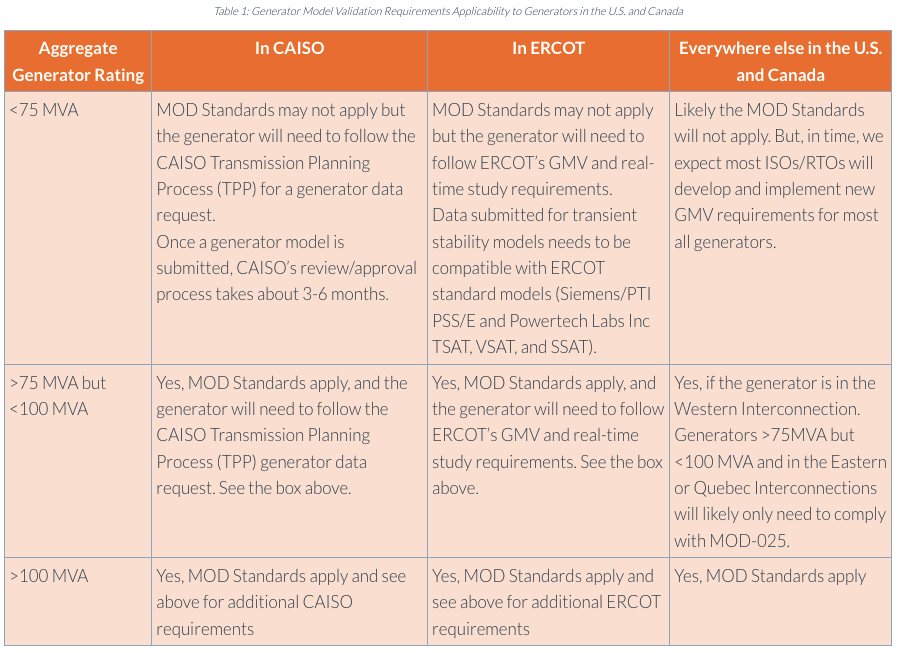The Background
Just a few years ago, the only generators that needed to worry about Generator Model Validation testing and reporting were those registered with NERC. Those registered generators must comply with three NERC Reliability Standards: MOD-025, MOD-026, and MOD-027, which essentially require Generator Model Validation (GMV) or in NERC’s words, “Verification of Models and Data.” Then the dynamics of the grid became more and more complex with the significant penetration of intermittent renewables. As the changing grid dynamics unfold (e.g., minuscule responses to minuscule changes in voltage and frequency multiplied by thousands of inverters can lead to major events), system operators noticed they need a higher quantity and quality data and models of the system.
And here we are today, whereby nearly every generator in CAISO and ERCOT, whether NERC-registered or not, has a GMV requirement. In CAISO, the generator has 120 days to perform these tests and report the data and updated models to its Transmission Planner (e.g., PG&E or SCE) and CAISO. In ERCOT, generators must perform GMV procedures and reporting as a requirement for COD. Why the increased requirements in CAISO and ERCOT? Their systems have seen some of the highest inverter-based renewable penetrations in the country. With this comes a heightened need for system and generator model accuracy.
What to Plan for as a Generator Owner?
The first question to answer is, “Will these GMV requirements apply to my generator?” If your generator is within the CAISO or ERCOT Balancing Authority Areas, the short answer is yes. If your generator is located outside these areas, the answer is a little more nuanced. Table 1 below details which generators, in most cases, do and do not have GMV requirements.

If one or more of your generators is subject to either the NERC MOD Standards or an ISO’s Generator Model Validation Requirements, you will want to begin planning for this pre-construction. Either shortly before or after your project reaches COD, you will be required to run the generator through its paces demonstrating how the resource performs when at maximum and minimum with real and reactive power output, and how it responds to voltage step changes and simulated high and low frequency events. When performing this staged test, certain data (e.g., MWs and voltage) will need to be recorded at a high sampling rate at various plant locations, such as at the POI, the high side of the GSU, and at an inverter. Recording data at a high sampling rate in these various locations can require renting and plugging-in expensive equipment. But with proper planning, a better alternative is enabling the high sampling rate data recording (“high-frequency recording”) function of your project’s SEL relays.
Once the initial staged test is performed, the data collected at the various plant locations will be used to validate your generator’s steady-state and dynamic models, which were submitted to your Transmission Planner during the interconnection phase of the project. Utilizing this test data, the inverter model, and the power plant controller (PPC) model, power engineers will use specialized software to analyze, validate, and update your generator’s steady-state and dynamic models. These updated models are then submitted to the generator’s Transmission Planner, Transmission Service Provider, and System Operator, along with various analysis and reports required by these entities. And when it comes to this reporting step, do not expect your first submission to be your last. There is often a back-and-forth with these entities to clarify data, answer questions, and update models.
It sounds simple but in each step of the process lies a rabbit hole that can consume resources and cause delays, budget surprises, and non-compliance violations and fines. But if you follow the simple checklist prescribed below and get in front of your obligations ahead of time, meeting these complex GMV requirements does not have to be a painful distraction.
Your Generator Model Validation Planning Checklist
Given the myriad of complexities and potential pitfalls, here is a checklist of items to plan for well in advance.
- Budget for GMV activity costs in the project’s construction, or pre-COD, budget and in the operating budget. There is an initial GMV requirement and a recurring analysis and reporting requirement every five years thereafter.
- Make sure you have the generator’s steady-state and dynamic models that were submitted during the interconnection phase of the project. These models are the starting point for the GMV process – i.e., these are the models that need to be validated.
- Talk to your inverter and PPC vendors about their equipment models and request they provide these models as part of their product scope in PSCAD format or any of the other formats (e.g., PSLF, PSS/E, and/or TSAT/PSAT) requested by the Transmission Planner(s) and/or Planning Coordinator. Vendors like Nor-Cal Controls are out in front of this and have already modeled its PPC in PSCAD. Visit norcalcontrols.net to learn more about its PPC, download the PSCAD PPC Model Validation brochure (halfway down its homepage), and start a discussion with Nor-Cal Controls.
- Work with your EPC and protection engineers to enable the high sampling rate data recording function of your project’s SEL relays.
- Make sure your generator is compliant with PRC-019, PRC-024, and PRC-025. Even if your generator is not registered with NERC, your generator will need to comply with these Standards. Analyzing your protection equipment against these Standards is beneficial both from a grid reliability and plant profitability standpoint.
- Depending on the location of your project, you will likely need special software (e.g., PSCAD, PSLF, PSS/E, and/or TSAT/PSAT) to compile and validate your generator’s inverter and PPC models and data using the data collected during the initial staged test. Locate a vendor with these capabilities early. Rush jobs can often lead to expedite fees.
Unique Considerations to Plan for in CAISO and ERCOT
CAISO
CAISO’s GMV requirements lie within its Transmission Planning Process (TPP) Business Practice Manual (BPM). These requirements culminate in a generator data request submittal requiring six or seven key elements that closely resemble NERC’s MOD-025, MOD-026, and MOD-027 requirements (See the
WECC Data Preparation Manual, pages 10 and 38). A common mistake to avoid is not planning for and incorporating unique TPP requirements in your MOD testing plans. Too often, generators treat the MOD and TPP requirements as two separate obligations and waste money going back to their vendors with additional requests and tests. Proper planning incorporates and anticipates the TPP requirements in the early stage MOD planning and analysis phase. This way, when your contractor develops the MOD test plan, TPP requirements are accounted for and part of that plan.
There are two unique requirements in the CAISO TPP worth noting that go beyond the MOD Standards. First, all generators need to perform a 10-second simulation of their steady-state and dynamic models using CAISO’s base case in GE’s PSLF software. Second, some synchronous and all inverter-based generators are required to develop and submit an Electromagnetic Transient (EMT) model for their generator. Learn more about the EMT model requirements
HERE. Both requirements go beyond the MOD Standards and should be planned for from a time and budget standpoint. Visit this
LINK to download a summary of the CAISO TPP Generator Data Request requirements and best practices to avoid the typical data and model deficiencies.
ERCOT
Like CAISO, ERCOT also has a couple unique requirements to consider and plan for. First, as mentioned, ERCOT requires the generator perform a staged test to validate the resource’s real and reactive power capabilities prior to COD (the “Part III” test). If planned for and performed correctly, a generator
may be able to use this test to meet some or all of its NERC MOD Standard and ERCOT generator model requirements. This can save your project both time and money. It is best practice to plan-ahead and discuss ahead of time the testing, modeling, and reporting requirements with the generator’s interconnecting Transmission Service Provider and Planning Coordinator. Obtain the applicable entity’s requirements and verify your testing and modeling plan will meet those requirements.
The second unique ERCOT requirement in the GMV process is the need for Powerflow and Short-circuit Analysis Tool (PSAT) and Transient Security Assessment Tool (TSAT) software to perform the generator modeling. This is a new requirement that is catching many asset managers off-guard. The software is not widely available and ERCOT’s requirements are evolving, so allow for plenty of time to perform the modeling and reporting.
A Quick Word About MOD-032
NERC Reliability Standard MOD-032 requires all balancing authorities, generator owners, load serving entities, resource planners, transmission owners, and transmission service providers to provide data according to the Transmission Planner (TP) and Planning Coordinator’s (PC) data request. This Standard is important because it does not state only NERC-registered facilities need to provide the data, even if you are not a NERC Registered entity you are required to provide accurate models per your interconnection agreement.
For generator owners of all sizes, this is important to keep in mind. For example, PG&E interprets this to mean any generator interconnected to their system is required to comply with the MOD-032 requirements. MOD-032 covers all generator elements that are modeled, as well as steady state, dynamic, and short circuit for conductors, transformers, VAR devices, etc. All generator elements are required to be modeled per the Participating Transmission Owner (PTO) and PC’s requirements. TPs and PCs refer heavily to MOD-032’s requirements when developing their modeling and data request needs and for base cases studies. Most WECC Regional entities utilize the WECC Data Preparation Manual to determine modeling requirements.
Don’t Wait Until the Last Minute
If there is one takeaway from all this, it is to not wait until the last minute. Plan-ahead and get in front of this early. Too often we receive calls from an operations or asset manager facing a deadline two months away. Two months may sound like plenty of time to perform these tests and meet these deadlines, but often it is not. Plus, waiting until the last-minute leads to expedite fees and missed opportunities to save money from proper planning (e.g., enable high-frequency recording functions in SEL relays to avoid equipment rental costs). So, if your generator is in the pre-construction or construction phase, or if you are facing a CAISO TPP Data Request due date that is a year away, now is the time to start developing your plan to meet the GMV requirements. Any questions? Give us a call. We’re happy to guide you through the process.



